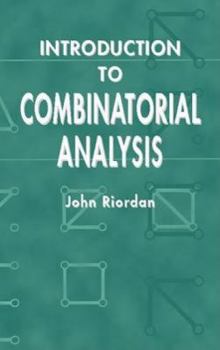Introduction to Combinatorial Analysis
Select Format
Select Condition 
Book Overview
This is a text that defines "the number of ways there are of doing some well-defined operation." Covers permutations and combinations associated with elementary algebra, generating functions, the principle of inclusion and exclusion, the cycles of permutations, the theory of distributions, partitions, compositions, trees, and linear graphs; and permutations with restricted position. Includes problems. 1958 edition.
Format:Paperback
Language:English
ISBN:0486425363
ISBN13:9780486425368
Release Date:December 2002
Publisher:Dover Publications
Length:256 Pages
Weight:0.65 lbs.
Dimensions:0.6" x 5.5" x 8.6"
Related Subjects
Combinatorics Math Mathematical Analysis Mathematics Pure Mathematics Science & MathCustomer Reviews
4 ratings
A very good old text
Published by Thriftbooks.com User , 15 years ago
The thing that borthers me is the archadic notation used in parts of this book and notation used with no reference that I can find. I really learned a lot in reading this book and intend to try to get more out of it in the future, but I really wouldn't use this as an introductory text as some of the theorems an problems are graduate or post graduate level. It is a useful and helpful book for those intent on understanding combinatorial theory.
Dated, but excellent
Published by Thriftbooks.com User , 16 years ago
As a "hobby mathematician", I had had exposure to this subject while studying related topics (e.g. random graphs), but this was the first book I studied, which was dedicated ot combinatorics only. The book seems easy reading, but I have a feel, a real mathematician will find a lot of depth in this book. Generating functions are explained in great detail. It is obviously written in the older style, not in the Definition-Theorem-Proof style, which I find easier to read. Still, it is a simple yet rigorous introduction into the field of combinatorics
A tangible account of something not so tangible
Published by Thriftbooks.com User , 17 years ago
I find combinatorics to be unattainable past the elements of combinatorics. In this introduction I can at least feel like I am walking away with something especially from the finer details and intracacies.
A Classic Text in the Subject
Published by Thriftbooks.com User , 17 years ago
This is a text which, while considered an introduction and perhaps a bit dated nowadays, requires some of the closest attention I have ever had to pay to a mathematical work. If I may call this book a mathematical gold mine, I must also say that in parts the digging is arduous and rewarding and the rock can be of high density. The section in chapter 2, on derivatives of composite functions (essentially Bell Polynomials, after the famous Eric Temple Bell), is an example. This is at least my third pass through the book and this time I decided not to slough over some of the details on these polynomials. I found myself bewildered for a couple of days, as the author gives no assistance to the reader--no doubt to help the reader develop some of that mathematical maturity mentioned in the preface--and found gold thereby. Statements made apparently as an aside, such as "completely determined..." had not been paid adequate attention by me. Also, it was not pointed out by the author that certain constants evaluated in the examples were found by setting the variable to zero, and so on. This is all left to the reader to dig out. In a span of two or three pages in this section there are hours of profitable work left to the reader. This is not a complaint, but rather a statement of the level of audience addressed by this book. It is not a text for readers who require hand-holding. However, anyone who is prepared to dig will experience the "joy of finding things out", if I may humbly steal a favored phrase of the late, great Richard P. Feynman.




